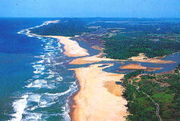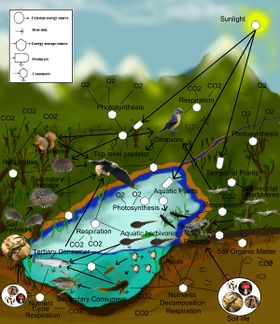Bioluminescence
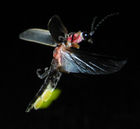
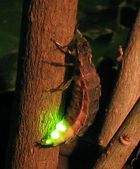
Bioluminescence is the production and emission of light by a living organism. Its name is a hybrid word, originating from the Greek bios for "living" and the Latin lumen "light". Bioluminescence is a naturally occurring form of chemiluminescence where energy is released by a chemical reaction in the form of light emission. Adenosine triphosphate (ATP) is involved in most instances. The chemical reaction can occur either inside or outside the cell. In bacteria, the expression of genes related to bioluminescence is controlled by an operon called the Lux operon. Bioluminescence has appeared independently several times (up to 30 or more) throughout evolution.[1]
Bioluminescence occurs in marine vertebrates and invertebrates, as well as microorganisms and terrestrial animals. Symbiotic organisms carried within larger organisms are also known to bioluminesce.
Contents |
Characteristics
Bioluminescence is a form of luminescence, or "cold light" emission; less than 20% of the light generates thermal radiation. It should not be confused with fluorescence, phosphorescence or refraction of light.
Ninety percent of deep-sea marine life are estimated to produce bioluminescence in one form or another. Most marine light-emission belongs in the blue and green light spectrum, the wavelengths that can transmit through the seawater most easily. However, certain loose-jawed fish emit red and infrared light and the genus Tomopteris emits yellow bioluminescence.
Non-marine bioluminescence is less widely distributed, but a larger variety in colours is seen. The two best-known forms of land bioluminescence are fireflies and glow worms. Other insects, insect larvae, annelids, arachnids and even species of fungi have been noted to possess bioluminescent abilities.
Some forms of bioluminescence are brighter (or only exist) at night, following a circadian rhythm.
Adaptations for bioluminescence
There are five main accepted theories for the evolution of bioluminescent traits:
Counterillumination camouflage
In some squid species bacterial bioluminescence is used for counterillumination so the animal matches the overhead environmental light seen from below.[2] In these animals, photoreceptive vesicles have been found that control the contrast of this illumination to create optiminal matching.[2] Usually these light organs are separate from the tissue containing the bioluminescent bacteria. However, in one species Euprymna scolopes these bacteria make up an integral component of the animal's light organ.[3]
Attraction
Bioluminescence is used as a lure to attract prey by several deep sea fish such as the anglerfish. A dangling appendage that extends from the head of the fish attracts small animals to within striking distance of the fish. Some fish, however, use a non-bioluminescent lure.
The cookiecutter shark uses bioluminescence for camouflage, but a small patch on its underbelly remains dark and appears as a small fish to large predatory fish like tuna and mackerel swimming beneath it. When these fish try to consume the "small fish", they are bitten by the shark, which gouges out small circular "cookie cutter" shaped chunks of flesh from its hosts.
Dinoflagellates have an interesting twist on this mechanism. When a predator of plankton is sensed through motion in the water, the dinoflagellate luminesces. This in turn attracts even larger predators which will consume the would-be predator of the dinoflagellate.
The attraction of mates is another proposed mechanism of bioluminescent action. This is seen actively in fireflies, which use periodic flashing in their abdomens to attract mates in the mating season. In the marine environment this has only been well-documented in certain small crustaceans called ostracod. It has been suggested that pheromones may be used for long-distance communication, and bioluminescence used at close range to "home in" on the target.
Repulsion
Certain squid and small crustaceans use bioluminescent chemical mixtures or bioluminescent bacterial slurries in the same way as many squid use ink. A cloud of luminescence is expelled, confusing or repelling a potential predator while the squid or crustacean escapes to safety. Every species of firefly has larvae that glow to repel predators.
Communication
Communication between bacteria (quorum sensing) plays a role in the regulation of luminesence in many bacterial species. Using small extracellularly secreted molecules, they are able to adapt their behavior to only turn on genes for light production when they are at high cell densities.
Illumination
While most marine bioluminescence is green to blue, the Black Dragonfish produces a red glow. This adaptation allows the fish to see red-pigmented prey, which are normally invisible in the deep ocean environment where red light has been filtered out by the water column.[4]
Biotechnology
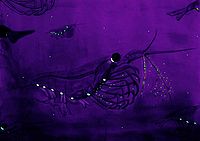
Bioluminescent organisms are a target for many areas of research. Luciferase systems are widely used in the field of genetic engineering as reporter genes. Luciferase systems have also been harnessed for biomedical research using bioluminescence imaging.
Vibrio symbiosis with numerous marine invertebrates and fish, namely the Hawaiian Bobtail Squid (Euprymna scolopes), are key experimental model for symbiosis, quorum sensing, and bioluminescence.
The structure of photophores, the light producing organs in bioluminescent organisms, are being investigated by industrial designers.
Proposed applications of engineered bioluminescence
Some proposed applications of engineered bioluminescence include:[5][6]
- Glowing trees to line highways to save government electricity bills
- Christmas trees that do not need lights, reducing danger from electrical fires
- Agricultural crops and domestic plants that luminesce when they need watering
- New methods for detecting bacterial contamination of meats and other foods
- Bio-identifiers for escaped convicts and mental patients
- Detecting bacterial species in suspicious corpses
- Novelty pets that bioluminesce (rabbits, mice, fish etc.)
Bioluminescent organisms
Omphalotus nidiformis


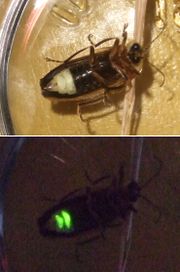

All cells produce some form of bioluminescence within the electromagnetic spectrum, but most are neither visible nor noticeable to the naked eye. Every organism's bioluminescence is unique in wavelength, duration, timing and regularity of flashes. Below follows a list of organisms which have been observed to have visible bioluminescence.
Terrestrial organisms
Animals:
- certain arthropods
- fireflies
- glow worms
- railroad worms
- certain mycetophilid flies
- certain centipedes
- certain millipedes
- a terrestrial mollusc (a tropical land snail)
- Quantula striata
- annelids
Fungi:
- Mushrooms (see Foxfire)
- Jack O'Lantern mushroom (Omphalotus olearius)
- ghost fungus (Omphalotus nidiformis)
- Honey mushroom
- Panellus stipticus
- several species of Mycena
Fish
- Cookie-cutter shark
- Marine hatchetfish
- Anglerfish
- Flashlight fish
- Pineconefish
- Porichthys
- Gulper eel
- Many rattails
Marine invertebrates
- many cnidarians
- certain Ctenophores or "comb jellies"
- certain echinoderms (e.g. Ophiurida)
- certain crustaceans
- certain chaetognaths
- certain molluscs
- certain clams, bivalves
- certain nudibranchs, sea slugs
- Octopus
- Bolitaenidae
- the order Teuthida
- Colossal Squid
- Mastigoteuthidae
- Sepiolidae
- Sparkling Enope Squid
- Vampire squid
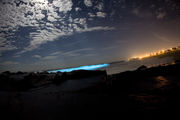
Microorganisms
- Dinoflagellates
- Vibrionaceae (e.g. Vibrio fischeri, Vibrio harveyi, Vibrio phosphoreum)
- Fungi species - A total of 71 species are bioluminescent[7] including species of Armillaria, Omphalotus, Mycena, Gerronema, Pleurotus.
See also
- Biophoton
- De Phenomenis in Orbe Lunae
- Foxfire
- Bioluminescence imaging
- List of light sources
- Milky seas effect
- Wheels of Poseidon
References
- ↑ Hastings,J.W. Biological diversity, chemical mechanisms, and the evolutionary origins of bioluminescent systems. J. Mol. Evol. 19,309 (1983)
- ↑ 2.0 2.1 Young RE, Roper CF. (1976). Bioluminescent countershading in midwater animals: evidence from living squid. Science. 191(4231):1046–8. PMID 1251214
- ↑ Tong D, Rozas NS, Oakley TH, Mitchell J, Colley NJ, McFall-Ngai MJ.Evidence for light perception in a bioluminescent organ. Proc Natl Acad Sci U S A. 106: 9836–9841 PMID 19509343
- ↑ Long-wave sensitivity in deep-sea stomiid dragonfish with far-red bioluminescence: evidence for a dietary origin of the chlorophyll-derived retinal photosensitizer of Malacosteus niger. by R.H. Douglas, C.W. Mullineaux, and J.C. Partridge
- ↑ Bioluminescent fireflies light way by Ron McAdow
- ↑ Bioluminescence Questions and Answers
- ↑ Bryner, Jeanna (5 October 2009). "Glow-in-the-Dark Mushrooms Discovered". Live Science. http://www.livescience.com/strangenews/091005-glowing-mushrooms.html. Retrieved 2009-10-06.
External links
- Bioluminescence web page
- Lights Alive! at San Diego Natural History Museum
- Bioluminescent fireflies light way
- Glow in the Dark Shark has Killer Smudge article describing cookie-cutter shark adaptation
- Glow with the Flow article from Scripps Institution of Oceanography
- Gonyaulax Bioluminescence at Monterey Bay Aquarium Research Institute
- glow-worms on the UF / IFAS Featured Creatures Web site
- Glowing life in an underwater world TED video from Edith Widder
- "Night Lights: Bioluminescence" Article about bioluminescent creatures in Hawaii by Shannon Wianecki. Maui No Ka 'Oi Magazine Vol.14, No.3 (May 2010)
|
||||||||||||||||||||||||||||||
|
||||||||||||||||||||||||||||||||||||||||||||||||||||||||||||||||
